Abstract
OBJECTIVES. The purpose of this study was to assess the costs and impact of a nutrition education program following a cholesterol screening. METHODS. Forty work-sites were randomly assigned to one of two educational interventions: a "usual" intervention of 5 minutes of counseling, or a "special" intervention of 2 hours of behaviorally based education on dietary changes to lower serum cholesterol. Costs were monitored, and cholesterol levels were retested 6 and 12 months later. RESULTS. The total per-person cost for screening and the educational intervention was about $50. Cholesterol levels differed little between the two intervention groups 6 months after screening, but after 12 months those in the special intervention worksites showed a 6.5% drop in cholesterol, whereas those at the usual intervention worksites showed a drop of only 3.0%. Hence a 3.5% cholesterol reduction was attributable to the special intervention. CONCLUSIONS. A behaviorally based nutrition education program following cholesterol screening can have a meaningful impact on long-term cholesterol levels at a low cost. Nutrition education in work-sites may therefore be a useful way to lower the risk of heart disease in communities.
Full text
PDF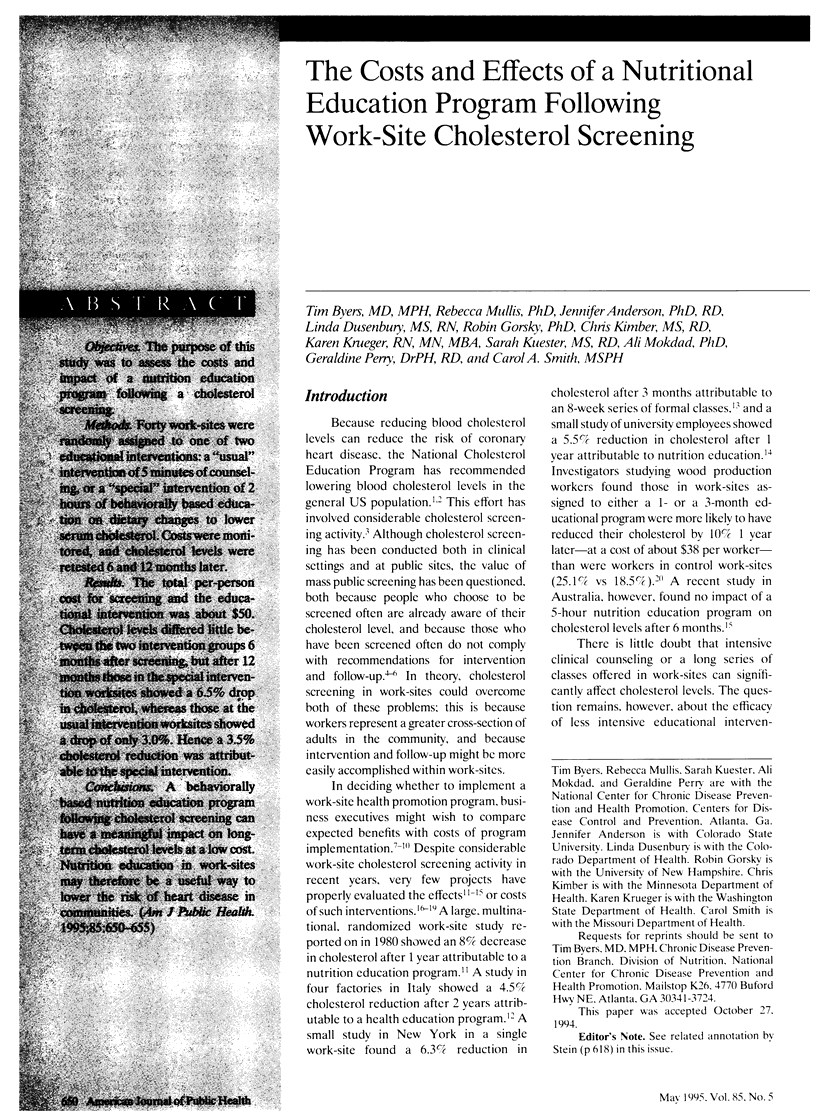
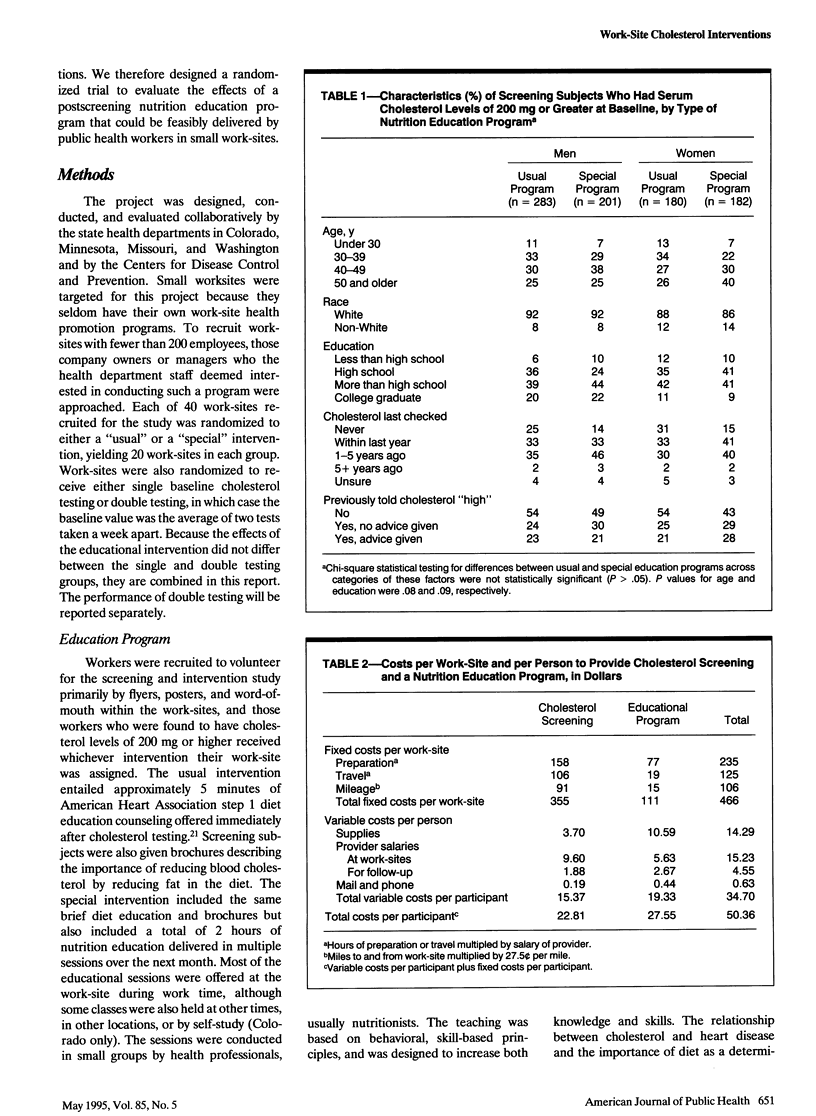
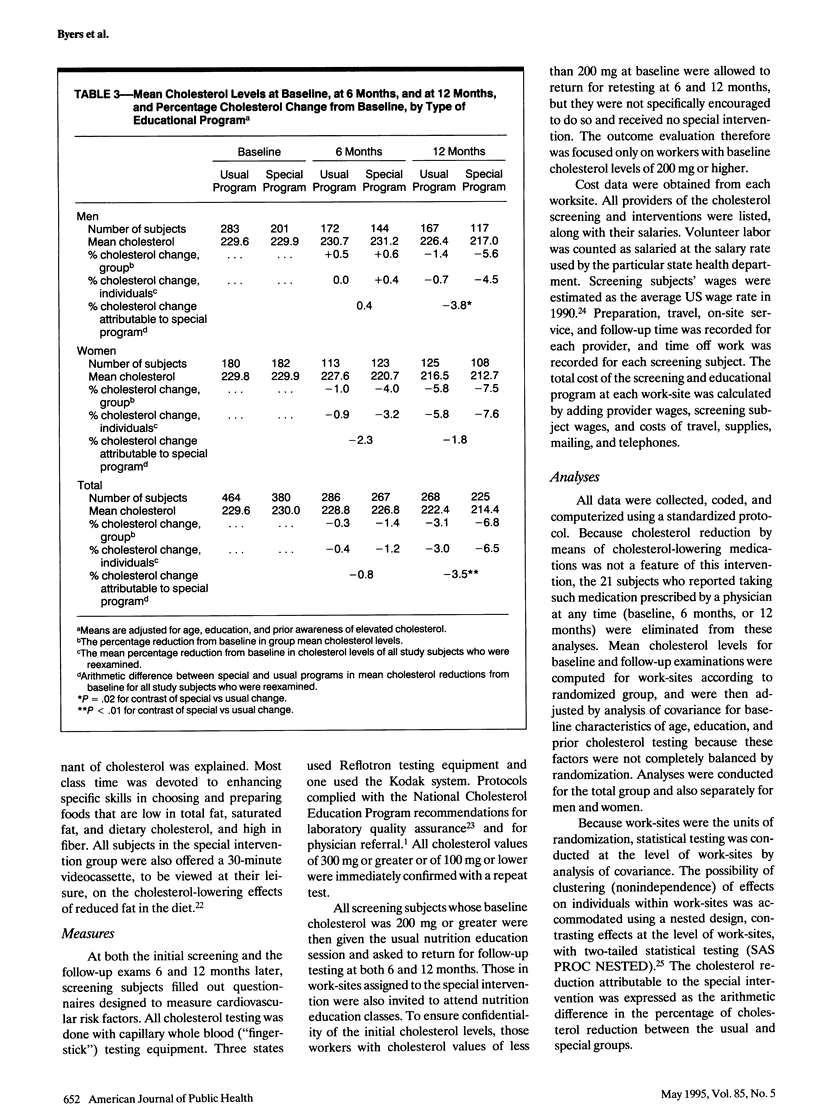
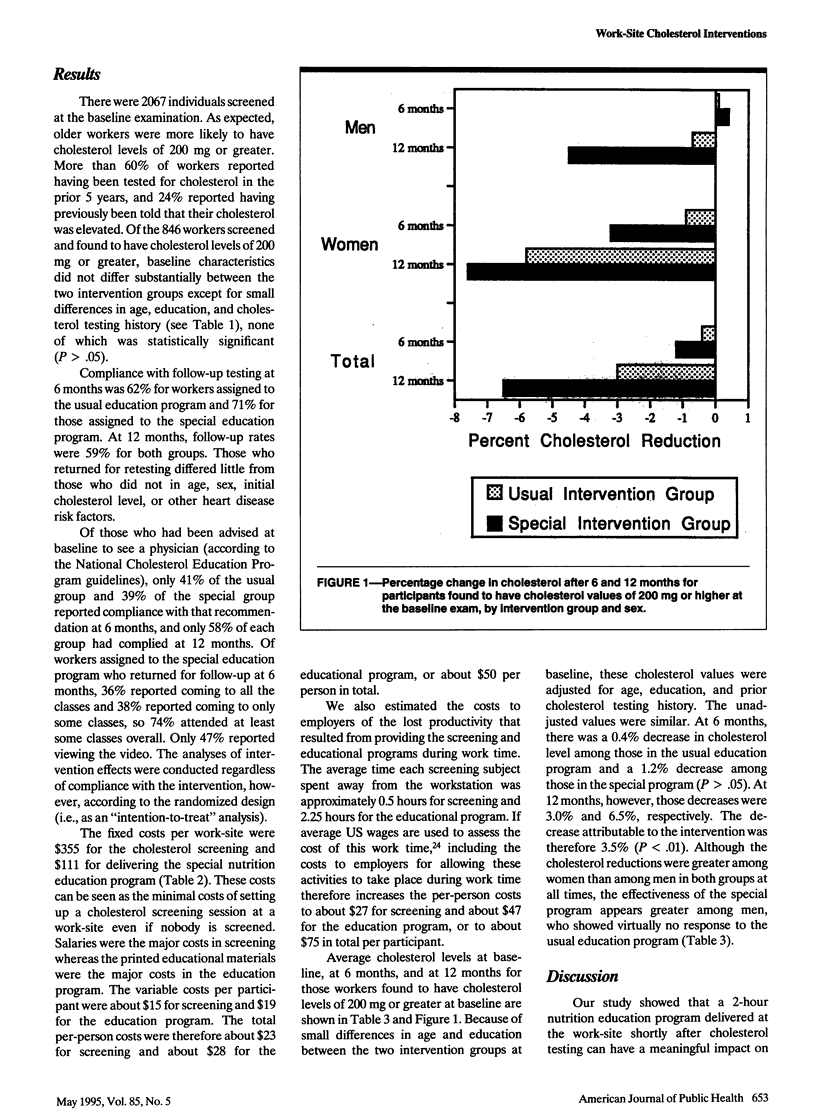
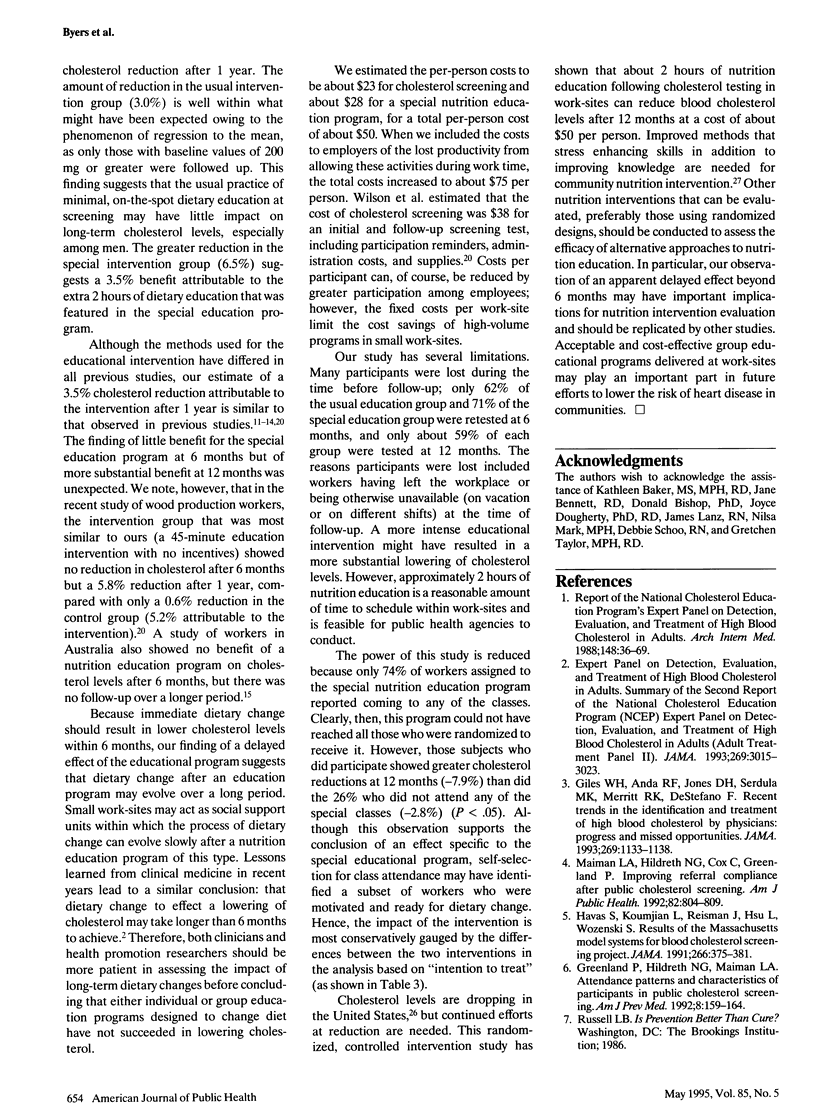
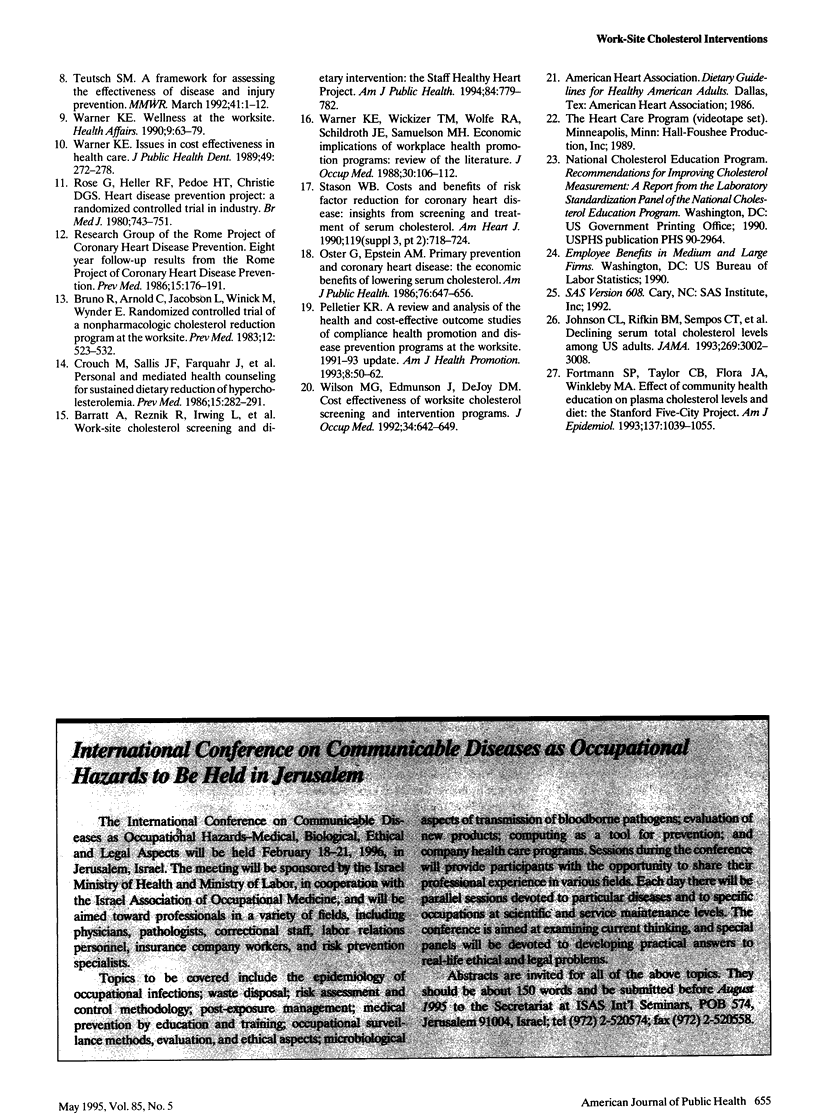
Selected References
These references are in PubMed. This may not be the complete list of references from this article.
- Barratt A., Reznik R., Irwig L., Cuff A., Simpson J. M., Oldenburg B., Horvath J., Sullivan D. Work-site cholesterol screening and dietary intervention: the Staff Healthy Heart Project. Steering Committee. Am J Public Health. 1994 May;84(5):779–782. doi: 10.2105/ajph.84.5.779. [DOI] [PMC free article] [PubMed] [Google Scholar]
- Bruno R., Arnold C., Jacobson L., Winick M., Wynder E. Randomized controlled trial of a nonpharmacologic cholesterol reduction program at the worksite. Prev Med. 1983 Jul;12(4):523–532. doi: 10.1016/0091-7435(83)90206-2. [DOI] [PubMed] [Google Scholar]
- Crouch M., Sallis J. F., Farquhar J. W., Haskell W. L., Ellsworth N. M., King A. B., Rogers T. Personal and mediated health counseling for sustained dietary reduction of hypercholesterolemia. Prev Med. 1986 May;15(3):282–291. doi: 10.1016/0091-7435(86)90047-2. [DOI] [PubMed] [Google Scholar]
- Fortmann S. P., Taylor C. B., Flora J. A., Winkleby M. A. Effect of community health education on plasma cholesterol levels and diet: the Stanford Five-City Project. Am J Epidemiol. 1993 May 15;137(10):1039–1055. doi: 10.1093/oxfordjournals.aje.a116608. [DOI] [PubMed] [Google Scholar]
- Giles W. H., Anda R. F., Jones D. H., Serdula M. K., Merritt R. K., DeStefano F. Recent trends in the identification and treatment of high blood cholesterol by physicians. Progress and missed opportunities. JAMA. 1993 Mar 3;269(9):1133–1138. [PubMed] [Google Scholar]
- Greenland P., Hildreth N. G., Maiman L. A. Attendance patterns and characteristics of participants in public cholesterol screening. Am J Prev Med. 1992 May-Jun;8(3):159–164. [PubMed] [Google Scholar]
- Havas S., Koumjian L., Reisman J., Hso L., Wozenski S. Results of the Massachusetts Model Systems for Blood Cholesterol Screening Project. JAMA. 1991 Jul 17;266(3):375–381. [PubMed] [Google Scholar]
- Johnson C. L., Rifkind B. M., Sempos C. T., Carroll M. D., Bachorik P. S., Briefel R. R., Gordon D. J., Burt V. L., Brown C. D., Lippel K. Declining serum total cholesterol levels among US adults. The National Health and Nutrition Examination Surveys. JAMA. 1993 Jun 16;269(23):3002–3008. [PubMed] [Google Scholar]
- Maiman L. A., Hildreth N. G., Cox C., Greenland P. Improving referral compliance after public cholesterol screening. Am J Public Health. 1992 Jun;82(6):804–809. doi: 10.2105/ajph.82.6.804. [DOI] [PMC free article] [PubMed] [Google Scholar]
- Oster G., Epstein A. M. Primary prevention and coronary heart disease: the economic benefits of lowering serum cholesterol. Am J Public Health. 1986 Jun;76(6):647–656. doi: 10.2105/ajph.76.6.647. [DOI] [PMC free article] [PubMed] [Google Scholar]
- Pelletier K. R. A review and analysis of the health and cost-effective outcome studies of comprehensive health promotion and disease prevention programs at the worksite: 1991-1993 update. Am J Health Promot. 1993 Sep-Oct;8(1):50–62. doi: 10.4278/0890-1171-8.1.50. [DOI] [PubMed] [Google Scholar]
- Rose G., Heller R. F., Pedoe H. T., Christie D. G. Heart disease prevention project: a randomised controlled trial in industry. Br Med J. 1980 Mar 15;280(6216):747–751. doi: 10.1136/bmj.280.6216.747. [DOI] [PMC free article] [PubMed] [Google Scholar]
- Stason W. B. Costs and benefits of risk factor reduction for coronary heart disease: insights from screening and treatment of serum cholesterol. Am Heart J. 1990 Mar;119(3 Pt 2):718–724. doi: 10.1016/s0002-8703(05)80051-1. [DOI] [PubMed] [Google Scholar]
- Teutsch S. M. A framework for assessing the effectiveness of disease and injury prevention. MMWR Recomm Rep. 1992 Mar 27;41(RR-3):1–12. [PubMed] [Google Scholar]
- Warner K. E. Issues in cost effectiveness in health care. J Public Health Dent. 1989;49(5 Spec No):272–278. doi: 10.1111/j.1752-7325.1989.tb02085.x. [DOI] [PubMed] [Google Scholar]
- Warner K. E. Wellness at the worksite. Health Aff (Millwood) 1990 Summer;9(2):63–79. doi: 10.1377/hlthaff.9.2.63. [DOI] [PubMed] [Google Scholar]
- Warner K. E., Wickizer T. M., Wolfe R. A., Schildroth J. E., Samuelson M. H. Economic implications of workplace health promotion programs: review of the literature. J Occup Med. 1988 Feb;30(2):106–112. [PubMed] [Google Scholar]
- Wilson M. G., Edmunson J., DeJoy D. M. Cost effectiveness of work-site cholesterol screening and intervention programs. J Occup Med. 1992 Jun;34(6):642–649. [PubMed] [Google Scholar]


